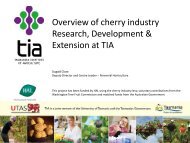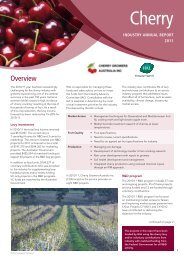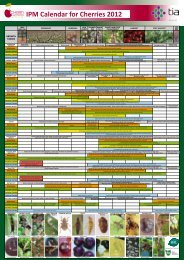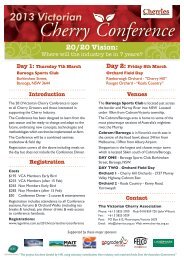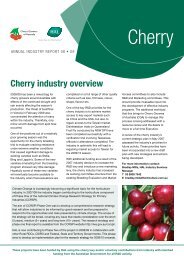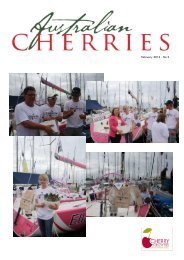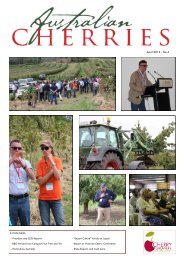April 2013 - No 10 - Cherry Growers Australia Inc
April 2013 - No 10 - Cherry Growers Australia Inc
April 2013 - No 10 - Cherry Growers Australia Inc
You also want an ePaper? Increase the reach of your titles
YUMPU automatically turns print PDFs into web optimized ePapers that Google loves.
LATEST CHERRY<br />
RESEARCH<br />
How well do fruit from highly irrigated trees perform post-harvest?<br />
Consistent results over two seasons have shown that cherry fruit from trees under high<br />
irrigation volumes were bigger and showed significantly reduced cracking levels compared<br />
to fruit from trees under lower volumes. This has a two-fold effect in that yield is both<br />
increased and improved. However, there was no difference in calcium levels in fruit from<br />
high and low-irrigated trees. So - at harvest, the quality of fruit from trees without any<br />
water stress was higher, but given they contained no extra calcium questions were asked;<br />
<br />
<br />
Did fruit from highly irrigated trees perform any better or worse during storage than<br />
fruit from trees with less irrigation?<br />
Was the increased size purely a function of water content that would result in a<br />
faster decline in quality post-harvest?<br />
During the second season of the irrigation trials post-harvest<br />
fruit quality assessments were included. Sweet cherry trees,<br />
variety ‘Sylvia’ on F12/1 rootstock, pruned to a bush system,<br />
in a commercial orchard in Southern Tasmania were used.<br />
‘Sylvia’ was chosen due to previous findings that when rainfall<br />
occurred, side cracks (resulting from water movement from<br />
the ground through the tree and into the fruit) made up over<br />
50% of all cracks in that variety (Figure 1). The trial site<br />
received 33.4 mm of rainfall in the three weeks prior to<br />
harvest, sufficient to cause fruit cracking in all of the irrigation<br />
treatments.<br />
Figure 1. Side-cracked fruit<br />
Calcium (total equivalent 11 kg.ha-1) was applied through fertigation on four occasions<br />
during early fruit development. In addition, irrigation treatments (high and low volumes)<br />
were applied throughout the growing season. Irrigation treatments were applied for the<br />
same duration for all plots and different volumes were achieved by either increasing (high)<br />
or decreasing (low) by 50% the volume of the standard irrigation (medium) set by the<br />
orchard. This occurred at a minimum soil moisture refill level of -40 kPa. Soil moisture was<br />
monitored by gypsum blocks at 15cm and 30cm soil depths of each treatment, with<br />
measurements taken 2-hourly during the season. This method resulted in a refill point for<br />
the high irrigation volume treatment of between -20-30 kPa, while the low irrigation volume<br />
treatment reached levels of -<strong>10</strong>0kPa or more before irrigation occurred.<br />
TIA – Irrigation and Post Harvest Page 1



